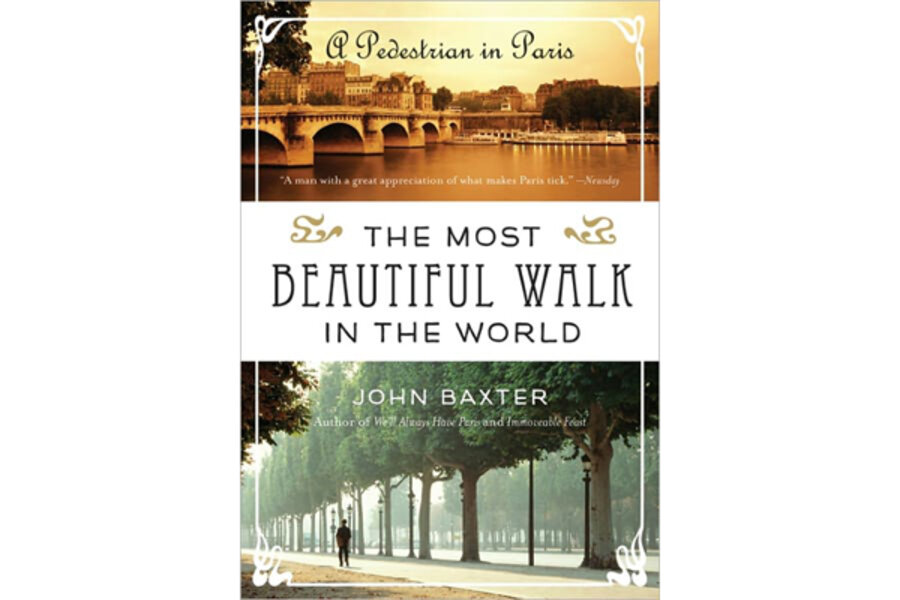"The Most Beautiful Walk in the World: A Pedestrian in Paris," by John Baxter
Loading...
Many Americans regard Paris as one of the most magnificent places in the world and a destination that should be visited frequently and savored. Some of our ancestors felt the same way: More than a century ago, the writer Thomas Gold Appleton proclaimed “Good Americans, when they die, go to Paris.”
John Baxter, a writer and film critic who has lived in Paris for the last two decades, would certainly agree. Having already authored two books about the City of Light, Baxter has now written The Most Beautiful Walk in the World, a new volume that focuses on the enormous pleasures to be gained from simply strolling about the city and carefully observing the everyday sights.
Parisians themselves, of course, have long appreciated the pleasures of a good walk and even invented a word, “flanerie,” to describe the activity. Baxter is a flaneur, par excellence. Fortunately, he’s also a superb writer and this allows the rest of us to enjoy the city with him. The book is really a loosely connected series of essays about how the author came to give tours of Paris: A friend asked him to lead a literary tour as a favor. He did the first tour, enjoyed it, and decided to spend a year as a high-end tour guide.
He quickly learns that conveying the kind of information found in a guidebook does not work as well as talking about the Paris he knows based on his own knowledge and observations. The “ah-ha” moment comes when he sees an opium pipe in a shop window and departs from standard tour guide patter to describe the role and place of opium in Paris. He quickly concludes that visitors don’t care much for statistics and dates but they crave stories and anecdotes.
The range and nature of his stories is amazing. Among other things, he discusses buying a Matisse etching with a wealthy friend; the cabarets; why the dream of a Parisian pied a terre often becomes a nightmare; the life of Henri Desire Landru, who married and murdered 10 women between 1914 and 1918; the city’s sidewalks and why you should always look down; visiting the catacombs; dining; finding a locksmith on Christmas eve; riding the Metro; the “allees;” the Blue Hour; learning to love fois gras; the simple pleasures of strolling through a market on a sunny day; and why he thinks his own street, L’rue de l’Odeon, is “the most beautiful walk in the world.” The well-known tourist attractions are secondary; his interest is the unique character of the city’s many neighborhoods and the day-to-day lives of Parisians.
As an author himself, Baxter is, not surprisingly, particularly interested in the literary history of the city – especially the expatriate Americans who lived there during the 1920s and 30s. He lives in the same apartment building as Sylvia Beach, the founder of the legendary bookstore Shakespeare and Company. Her good friend Ernest Hemingway makes regular appearances in the text.
The frequent references to literary history and the evocative descriptions of strolling through the city call to mind “Midnight in Paris,” Woody Allen’s latest movie. Readers who have seen the film will undoubtedly recognize many similarities and even wonder if Allen’s film could have been inspired by the book. (It was not.)
Baxter is also a film critic and so movie references are common. Some are insightful and appealing, but others are fairly obscure and likely to be lost on the average reader.
Baxter is a witty writer and some of his stories are laugh-out-loud funny. He seems particularly amused by the combination of enthusiasm and naïveté that some American visitors bring with them. He describes what happened after convincing a Texan (on her first overseas trip) to sample classic tartare – minced raw steak seasoned with chives, black pepper, Tabasco and Worcestershire sauce: “ ‘Just like chili,’ said Mary Beth, shoveling down a forkful. ‘Only ya don’ cook it! I’m gonna serve this sucker first barbecue I do back home.’ ” (sic)
In the end, this is a warm and affectionate meditation on the joys of walking in Paris and contemplating all that the city has to offer. Baxter is a keen and clear-eyed observer with an exquisite gift for finding and describing the telling detail. If you like Paris, you’ll love this book.
Terry Hartle is a Monitor contributor.






